I used the wrong fabric, and so the garment’s a fail. But the pattern isn’t, and now I know how to put it together. Hey, that’s what a “muslin” is all about, right?
Here’s the picture on the Au Bonheur des Petites Mains website:
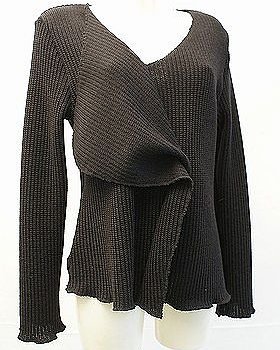 Cute, isn’t it? It’s a “pull” or sweater (or maybe a “pullover sweater” — I’m not up on current French slang). It’s a pretty simple-seeming pattern — back, sleeves, a decorative pleat in front where the two sides overlap.
Cute, isn’t it? It’s a “pull” or sweater (or maybe a “pullover sweater” — I’m not up on current French slang). It’s a pretty simple-seeming pattern — back, sleeves, a decorative pleat in front where the two sides overlap.
This pattern’s been out since 2009, and I’ve only been able to find two other examples of it made up. One was turned into a cardigan, and the other is a blog post with no notes at all. (I’ve noticed that this is often the case with many French bloggers.) That seems particularly strange since it’s relatively simple to put together, and it’s so darn cute. Here’s my “muslin”:
This “pull” is meant to be made from a thicker sweater knit. My fabric is “mystery composition” from Jomar, and I’m pretty sure it’s full of wool of the acryl. It loves itself, and sticks together as if it’s made of hook and loop tape. See those sleeves? They’re stuck that way. Icky, really.
The material did have a nice hand on the bolt, and I assumed, wrongly, that it had a lot more rayon than it seems to. Nevermind, it has served its purpose.
The pattern directions are almost non-existent, but they’re not really needed. Basically, they say to sew the shoulder seams together, and then attach the sleeves, sewing in one long seam under the arm and along the sides.
Then you are supposed to place the right front on the left front, and stitch down from point A on the pattern, matching the center front lines as marked on the pattern. This is a less than perfect instruction due to vague lines that are the same for all sizes, and no matching points A. On the other hand, it’s not difficult to figure out what’s meant.
This stitching line does not show on the line drawing that comes with the pattern, nor is it shown on the website. However, if you look closely, I think you can see a hint of its existence.. The knit fabric is supported vertically to the left (as you look at the photo) of the angled flange. (And, by the way, the asymmetry of the hem is far more exaggerated on the pattern than in the drawing, too. That point is actually quite far left.)
On Stitcher’s Guild it was mentioned that it looked as if the model garment were pinned to the form underneath; it’s not. That center front stitching line is what keeps the garment together. This line would presumably completely disappear in the correct, bulkier fabric.
Though it’s actually pretty hard to see even in this thin solid. You probably just barely can see the vertical stitching line to the left of the pleat.
Then you make a pleat, matching two lines that are not of corresponding lengths, and stitch along where the lines join. Folding the right collar at the top of this pleat gives this top its distinctive style. Although the directions have you make the pleat after stitching the front down, I found it easier to reverse the two steps, and form the pleat first.
The pleat is folded in toward the garment; that’s not stated in the directions, but it’s the only way to get the same look as in the line drawing. I stitched-in-the-ditch to keep this pleat in place; without this additional step, all definition was lost due to my thin fabric. I’m not sure it would be necessary in a sweater knit.
The neck, front, lower, and sleeve edges are left unfinished, or finished as you please (lettucing, etc.). I used tape to stay the left neck edge and the back neck — a colossal mistake, as you can see. These edges do need support, but clear elastic would have been a better choice. Or maybe I just did this badly; by the time I reinforced the neck, I knew this was probably something I wouldn’t wear.
As previously mentioned, the back hem is far more asymmetrical than the line drawing indicates, and it also doesn’t work at all in this clingy fabric, since it just sticks wherever it lands. If I ever wear this top, I’ll have to cut away the dip in the back hem.
If I were attempting this in another lightish knit, I’d probably cut the shoulders a bit narrower, as my dummy is larger than I am, and this is pushing the limits on the large end of my personal scale. This size would probably be just right for a sweater, though.
Here’s the cardigan version, from the French blog Passion Plaisir in wool:
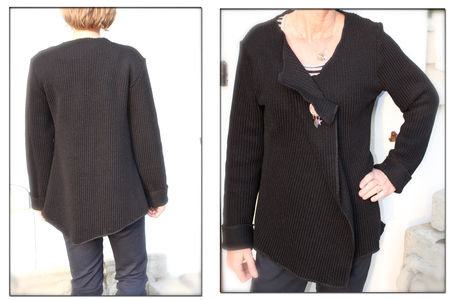 She hasn’t sewn the pleat in; she’s created the effect with a pin, and she’s not sewn the center vertical line, either, of course. It makes a very nice cardigan, doesn’t it? You can see in this example, as well in Au Bonheur’s model, how much better the thicker knits work.
She hasn’t sewn the pleat in; she’s created the effect with a pin, and she’s not sewn the center vertical line, either, of course. It makes a very nice cardigan, doesn’t it? You can see in this example, as well in Au Bonheur’s model, how much better the thicker knits work.
The verdict: Pattern success; execution fail. I’ll bring this pattern out again in the fall, once I’ve found a bulky knit I like, preferably in lovely, luscious wool.

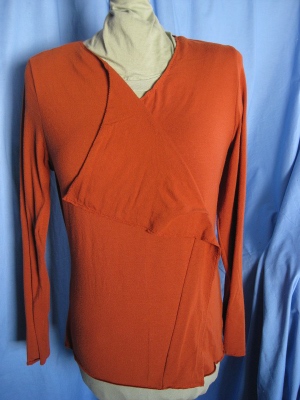
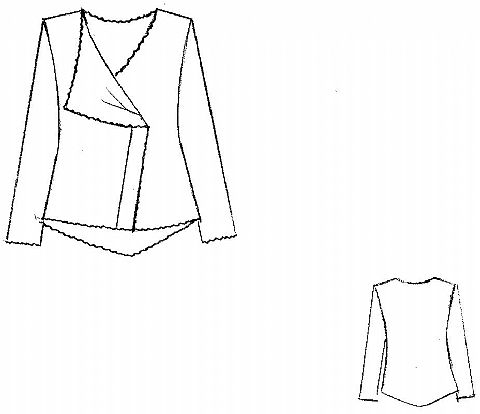
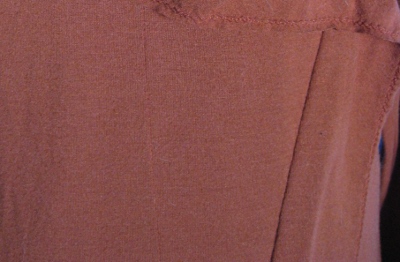


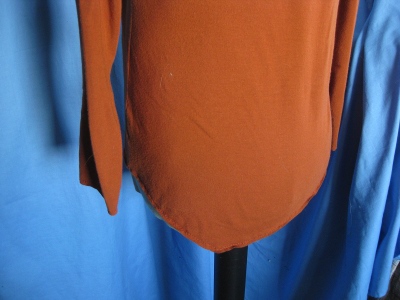
Noile, thanks so much for this post. I so enjoy your sewing reviews and am really taken with the Au Bonheur patterns you’ve been making. Such a pity they are no longer around. I hope you find the wool, as others have said this has great potential and is very stylish!
Thanks, Dilliander, for your comment. Many of us were heartbroken when Au Bonheur folded, but I’ve got a good library of their patterns, and will be sewing more in the months ahead. (And I think I’ve found a more suitable material for this top, too!)
Definitely potential here! Now that you’ve worked out the kinks you just need the perfect fabric for it.
Absolutely, Trena! Now I’m destined to spend the entire summer searching for wool . . .
I absolutely love this pattern. It’s such a good illustration of how a few simple lines can add up to so much more than you’d think.
This has *great* potential, Noile. In the right fabric, this will be stunning and perfect on you. You did get that JoMar fabric sewn up quickly. 🙂
You and Trena said it — there’s great potential here. Must. Go. Fabric. Shopping.
Um, I’m afraid this was an earlier Jomar, the one in Norristown. The haul from our recent trip has been removed from bags and admired, but is still piled, otherwise untouched, on the sewing room floor.
This is so beautiful! I think that I am too new to sewing to try it, I love the style!
Nora 🙂
I don’t know, Nora — it takes just a bit of thought, but really it’s very much like a cardigan with the two fronts sewn to each other. In any case, don’t be too intimidated — sometimes the projects that make you almost pull your hair out end up teaching you the most!
I really like the pattern concept! “This old thing? Oh I just threw it together- you know, a seam here, a seam there, two sleeves…Yes, it is comfortable…Yes, thanks I love it too!”
Now though, every time I see a nice bulky knit I am going to think of this pattern and you! Please let me know when you find the Perfect Knit for it!
Funny, Connie! I think maybe one reason I like these patterns so much is that they do have a lot of that “thrown together” mien about them — but, at heart, they’re really a bit more complex than that, even while appearing so tossed off.
I hope I can find some of those good bulky knits here — maybe I should be thinking fabric shopping in Canada for the fall!
Thank you so much for posting this “execution fail.” It helps me to know that experienced and talented sewists like yourself sometimes make the sort of poor choices I seem to make every day. I love your blog!
Oh, KC, I have “execution fails” all the time! Sometimes I just don’t listen to that little warning voice, and other times I think “it might work!” and I just have to try it out. Sometimes I just go with the process, and the results aren’t always pretty — but I always learn something, which makes it very much worthwhile. Thanks very much for your enthusiastic words!